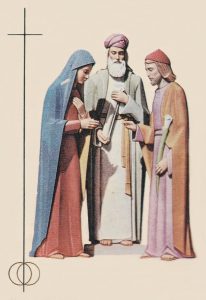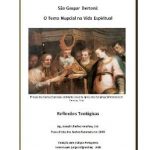January 23rd: Every year, on this date, the Stigmatines observe their “Patronal Feast”, the Holy Spouses, Mary and Joseph – as they also celebrate their marriage, their Holy Espousals. While the Founder most rarely ever mentioned this Feast in his writings, it is clear that the Feast was observed from the beginning of the foundation in 1816. It is an old Franciscan – and is observed by Stigmatines as a spiritual understanding of their commitment to their Apostolic Mission. As a man marries his spouse, so the Stigmatine is called to be joined evermore to Jesus Christ, and to commit himself always more intensely and competently to the progress of the Church.
†
St. Gaspar Bertoni: Biblical and Theological Reflections on his Devotions, the Holy Espousals and the Sacred Stigmata
This present effort presented here is only one attempt – using the very words of those who are more competent in different areas of study – to suggest some thoughts, from a variety of sources, concerning the Stigmatine Devotions, and principally, the Holy Spouses and the Sacred Stigmata.
 | St. Gaspar Bertoni: Biblical and Theological Reflections on his Devotions, the Holy Espousals and the Sacred Stigmata |
†
Stigmatine Devotions
Paluch Lecture at Mundelein Seminary on April, 2008
The devotions of St. Gaspar Bertoni are basically that to the Holy Spouses, Mary and Joseph, and their Espousals. In his earlier studies, the Stigmatine historian Father Giuseppe Stofella ordered a good explanation of the choice of his devotion for the Stigmatine community. Historical reasons may be simply that the painting of the Holy Espousals that hung over its main altar, depicting from an earlier Franciscan devotion, and that his might have inspired the Founder. It might also have been in that St. Gaspar did not have a happy home: his father abandoned the family, leaving St. Gaspar [the only surviving child of his parent’s marriage].
Whatever the reason, a good insight into the principles that motivated St. Joseph is the ‘Fiat’ of Mary to God’s Word and St. Joseph’s response to the Angel of God in the night [so beautifully developed by St. John Paul IInd, in his Exhortation Redemptoris Cussos]. This is the Patronal Feast of the Stigmatines [celebrated January 23rd].
As for the integral devotion to the Sacred Stigmata – the Sorrowful Wounds of Good Friday, and the Glorious Wounds of Easter Sunday [cf. Jn 20], sending the Apostles on showing them His Sacred Stigmata as He sent them on His Apostolic Mission. While St. Gaspar was not a ‘stigmatist’ in the formal sense, he lived the sufferings of the Merciful Lord in the deaths of his loved ones in early life; the separation of his parents; the life-long poor health that he endured, and the lack of fulfillment of some of his sublime hopes. This is the Titular Feast of the Stigmatine Congregation. It is celebrated the week of ‘Mercy Sunday’, with a special commemoration on Friday of that week.
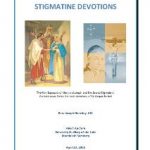 | Stigmatine Devotions [Paluch Lecture at Mundelein Seminary on April, 2008] |
†
The “Espousals Principle”
Fr. Bertoni offers a graduated, progressive approach to the various ways in which one might follow Jesus Christ: “very many” follow Christ for the reward [cf. Mt 6:2]; “many” follow Christ as slaves, but the slave does not know what the Master does [cf. Jn 15:15]; “some” follow Jesus as sons, but they are more interested in the inheritance [cf. Is 1:2]. “A few” may follow Jesus as friends, and base their whole relationship on the communication of Goods, but not be willing to share in His hardships, as the Apostles at first [cf. Mt 26:56; Ph 2:21].
Then, the Stigmatine Founder adds: “Very, very few follow Him as lovers, who in their youthful fire of their tender love follow Christ wherever He might go, either to Thabor, or on Calvary. But, the Spouse, the adult in the school of love, is not drawn by the pleasant odor, but is drawn by the right hand of the Spouse: ‘Draw me’ [cf. Sgs 1:3], and, by his strong arm, they are embraced and find support from His strength, so that they keep pace with Him, and do not merely run with Him, but even fly…’. Who is this, leaning on Her beloved? [cf. Sgs 8:5].
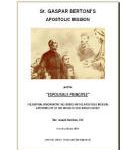 | The "Espousals Principle" |
†
The Nuptial Theme in the Spiritual Life
In the long history of the Church, many devotions have come and gone, and some of these reappear with some popularity with the passing of time. The immediate occasion of the Stigmatine observance of the Feast of the Holy Spouses, Mary and Joseph, on January 23rd each year, could easily have stemmed from the fact that St. Gaspar Bertoni [October 9, 1777- June 12, 1853] found the classical painting of the Holy Spouses hanging over the main altar, of a little Church in Verona, Italy, dedicated to the Stigmata of St. Francis. The Marriage of Mary and Joseph, in the Franciscan tradition, was a festival that inspired much devotion, also due to St. Francis’ commitment to his ‘marriage’ with Lady Poverty.
†
Gaspar Bertoni: Priest of Verona, Founder of the Stigmatines. His Devotions and Service of the Church:
The Sacred Stigmata of the Lord, the Espousals of Mary and Joseph and the Sacred Heart.
Extracted from Symposium held for the Canonization of the Stigmatine Founder. October 28, 1989. Rome: Angelicum pp. 143-160.
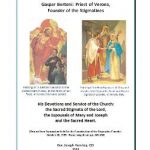 | Gaspar Bertoni: Priest of Verona, Founder of the Stigmatines. His Devotions and Service of the Church: The Sacred Stigmata of the Lord, the Espousals of Mary and Joseph and the Sacred Heart |
†
Stigmatine Devotions: the Espousals and the Stigmata in the Apocalypse
In the Stigmatine world, we often thought about our Devotions to the Sacred Stigmata both Sorrowful and Glorious – and the Espousals of Mary and Joseph as to stem from the fact that St. Gaspar Bertoni was a life-long invalid, very capable Confessor – and that he came from a broken home, his father abandoning the family unfaithfully pursuing his own personal interests.
But there is a deeper reason: in Fr. Raymond Brown’s classical treatment of the 4th Gospel, the author has presented Jon’s Book of Signs [J 1-112] as centered around liturgical festivals: the Sabbath; the Passover [Jn 5-6]; and the Feast of Ingathering, the Harvest, Tents, Tabernacles in the fall of the year [Jn 7-8]. In the spring-time, there was the Festival of Blood and the sacrificial Lamb – in the autumn of life, all returned to the Sheep-pen to hunker down during the winter rains.
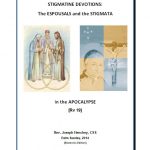 | Stigmatine Devotions: the Espousals and the Stigmata -in the Apocalypse |
†
The Holy Spouses Mary and Joseph: the Two Lilies of Winter
In the Stigmatine Seal, there are two lilies, representing Mary and Joseph. They are found under the five stars in the field of a blue sky and sea, representing the Sacred Stigmata. The lilies flourish in the part of the seal colored red: the liturgical color for the Holy Spirit, the Apostles, martyrs and may be reminiscent of charity.
 | The Holy Spouses Mary and Joseph: the Two Lilies of Winter |
†
St. Catherine of Siena: A Historical and Prophetic Synthesis of the Consecrated Life
The Espousals of Mary and Joseph, and the Sacred Stigmata of Jesus Christ, are an essential part of the spiritual heritage of St. Gaspar Bertoni.
A Lived Experience of the Espousals with Jesus Christ and His Sacred Stigmata.
Extracted from the Acts of the International Congress of Catherinian Studies. Siena – Rome: April 24 – 29, 1980. Roma: Curia Generalizia OP, 1981 [pp. 632 – 652].
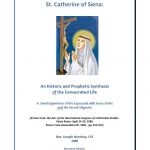 | St. Catherine of Siena: A Historical and Prophetic Synthesis of the Consecrated Life |
†
The Cross of San Damiano
With insights of St. Gaspar Bertoni
This is the Icon that much – inspired St. Francis of Assisi, inviting him to go, to repair the Church founded by Christ in His sufferings, death, resurrection and ascension – and on Pentecost. This Church is constantly in need of renewal. This Icon is an invitation to pray, beginning with the bottom of the scene, to its implication of the Ascension – noting Christ taking a step upward into the Heavenly Choir. This is a contemplation in color of the source of eternal life.
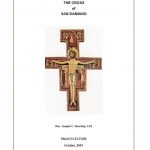 | The Cross of San Damiano [with insights of St. Gaspar Bertoni] - Paluch Lecture by Rev. Joseph Henchey, CSS [2007] |
†

